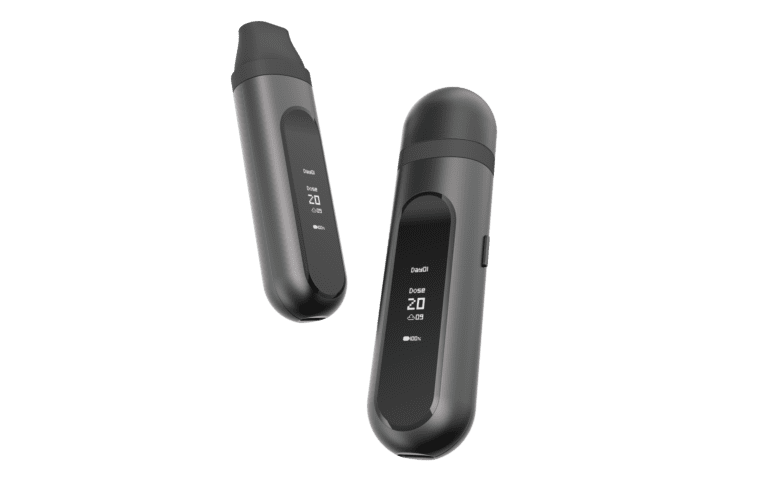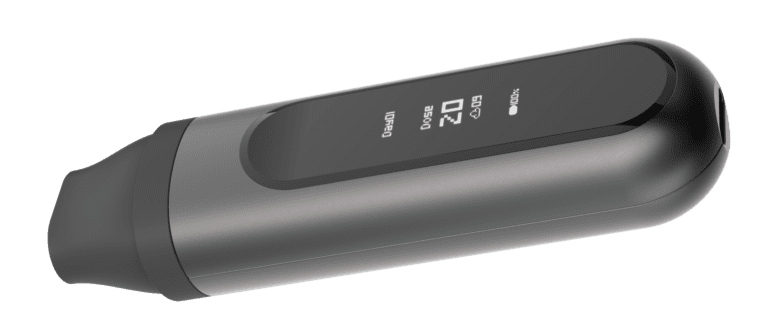High-Tech Quitting
- Also in TR Harm Reduction
- March 1, 2023
- 0
- 9 minutes read


Qnovia wants to increase smoking cessation rates with a disruptive inhaler technology.
By Stefanie Rossel
For smokers eager to quit, there’s a plethora of nicotine-replacement therapy (NRT) products on the market. However, whether they come in the form of lozenges, patches, gums, nasal sprays or prescription inhalers, the effectiveness of these cessation aids is disappointingly low. A study conducted by the Swiss Institute of Social and Preventive Medicine in 2006 found that the chance of a smoker quitting cigarettes long-term with the help of NRTs was a mere 7 percent. There’s no sign that this rate has improved in recent years. The poor performance is due in part to the fact that NRTs fail to provide instant relief of the physical sensations that contribute to cravings.
Qnovia, a Richmond, Virginia, USA-based medical technology and pharmaceutical company established in 2018, has set out to address this shortcoming with a new drug delivery technology. The firm has developed RespiRx, a handheld, pocket-size device capable of producing a medically safe aerosol without heat. The device consists of a vibrating mesh nebulizer, which is a combination of a vibrating piezoelectric actuator and a piece of mesh that diffuses a drop of liquid into a fine mist on contact.
Piezoelectric materials can produce electric energy upon application of mechanical stress. A commonly known piezoelectric is quartz. The technology, which usually involves clunky equipment and requires regular cleaning, has been used for many years for applications unrelated to smoking cessation.
Qnovia has made it more user-friendly, according to Qnovia CEO Brian Quigley, who spent 16 years with Altria Group, including seven as president and chief executive of the company’s smokeless and innovative products/vapor businesses.
“Vibrating mesh nebulization is a proven and safe method for delivering inhaled therapies; however, our proprietary device is designed to be orientation-agnostic and requires no cleaning or maintenance,“ he says. “Not only are there proprietary elements to achieve this, but the entire nebulizing engine is also miniaturized and part of the drug product containing carriage that continuously feeds the drug to the mesh, maintaining a controlled flow rate and thereby delivering a precise dose when activated with the user’s breath.”
The device works with a 12-week step-down dosage regimen consistent with other Qnovia NRTs. Every three seconds of inhalation registers as an individual dose, with a running count displayed on a panel of the battery unit. Working with a general practitioner or tobacco treatment specialist, patients are given a tapering dosage schedule according to their own consumption level. The concentration of pharmaceutical-grade nicotine in the cartridges remains constant over the duration of the program, with the device limiting the dispensation of doses in a single day and adjusting the limit per the regimen.
RespiRx has a higher pharmacokinetic curve than existing NRTs but a lower one than combustible cigarettes so that patients require progressively fewer doses as cravings subside. According to Quigley, one of the largest problems with existing buccal and transdermal solutions is that they don’t deliver the nicotine to the bloodstream quickly enough to alleviate withdrawal symptoms.

Vibrating mesh nebulization is a proven and safe method for delivering inhaled therapies; however, our proprietary device is designed to be orientation-agnostic and requires no cleaning or maintenance.
Unique Features
While RespiRx, with its high-tech design and elaborate features, may resemble an electronic cigarette, it is in fact a very different product, according to Quigley. “At its core, our device is a medical technology designed to achieve the FDA’s [U.S. Food and Drug Administration] Center for Drug Evaluation and Research’s [CDER] standards for safety,” he says. “So our device has multiple design features that make it wholly different than an e-cigarette. First, we use no heat to create the aerosol, which ensures there is no risk of exposing the user to thermal byproducts or degradants. Second, our drug product is also designed only using excipients that are safe for inhalation in a drug context, and third, the design of the device is meant to achieve CDER safety standards for airpath and safety, which are not requirements achieved by e-cigarettes.”
RespiRx’s technology also differs from Kind Consumer’s Voke, a breath-activated device that worked like an asthma inhaler. The product was designed to deliver rapid nicotine craving relief without heat, combustion or vapor. It looked like a cigarette, and its consumption ritual mimicked smoking.
The U.K. Medicine and Healthcare products Regulatory Agency granted Voke a medical license in 2015, and Public Health England endorsed the product as a safer alternative to smoking. However, after raising £140 million ($171.42 million) and attracting investments from major companies, including BAT, the venture ended in late 2020.
According to Quigley, Voke delivered the user a cold shot of compressed polybutylene—in essence, a pressurized nicotine liquid, which appears to have impacted the user experience.
By contrast, Qnovia’s device delivers a laminar, nonturbulent aerosol. “Not only does our aerosol appear to look vapor-like, but it’s also designed to be inhaled easily under normal inspiratory conditions, unlike the Voke,” says Quigley.
Quigley is confident that RespiRx won’t suffer the same fate as Voke. “Firstly, the RespiRx’s on-device LCD screen prompts and future mobile app connectivity will play important roles in advancing patient adherence and compliance rates,” he says. “These tech-enabled features simply didn’t exist with Voke’s low-tech, data-absent approach. Secondly, from a broader drug-delivery platform perspective, the RespiRx is actually able to deliver complex, pressure-sensitive molecules like biologics. Voke was tied to one indication area, where the underlying technology for broader API adoption would have been a challenge. The RespiRx, on the other hand, is already engaging in activities to expand Qnovia’s active pharmaceutical ingredient portfolio beyond nicotine.”
According to the company, the RespiRx technology could be used to deliver a variety of drugs for various future indications, including asthma, chronic obstructive pulmonary disease or chronic pain.

Into the Clinical Trial Phase
In the NRT category, RespiRx will compete with FDA-approved nicotine inhalers such as Nicorette, which is available without a prescription. Quigley believes RespiRx will prove to be a more effective solution.
“The Nicorette inhaler delivers large droplets containing nicotine into the patient’s mouth,” he says. “This results in buccal absorption, so it’s not an inhaled delivery mechanism despite its name, which limits the ability of the drug to rapidly and effectively alleviate withdrawal symptoms, where our device delivers an aerosol with particle dynamics that deliver the drug to the lung, which will result in more immediate drug delivery and improved ability to alleviate withdrawals. Also, the inhaler has a very harsh and bitter taste, which limits adoption, whereas our formulation does not have these unpleasant effects.”
Making smoking cessation medication—or novel nicotine-delivery products for that matter—permanently acceptable for smokers continues to be a challenge. Quigley says RespiRx’s formulation has no flavor. Since the product’s target audience is looking to ultimately stop consuming tobacco products altogether, they want an experience that is different from that offered by existing alternatives and one that helps them move away from smoking over the 12-week user regimen.
In October 2022, Qnovia raised $17 million to help RespiRx through the FDA’s Investigational New Drug Application process. “Once we submit our IND, we will execute phase I, II and III studies with FDA guidance; however, the study design, powering and endpoints are all already very clearly defined,” says Quigley.
The company plans to submit its final new drug application to the FDA in 2025. Approval is likely to come faster than for new tobacco products going through the FDA’s premarket tobacco product application process. “At the appropriate time, we expect to also request breakthrough and accelerated review status, which are established programs to facilitate the submission, review and final decisions for drugs,” says Quigley. “Largely, I believe CDER does a very good job hitting its timing performance requirements, and the burden of proof we have to demonstrate is clear and well defined. For all these reasons, I believe we have a significant advantage engaging with CDER despite the cost and time we invest in generating strong data for the agency.”
Instead of marketing RespiRx as an over-the-counter product, Qnovia has chosen to pursue prescription-only status. “We believe that it is important to ensure that this therapy is only used as intended, and we want to be sure to not have abuse liability concerns. Given the design of the pharmacokinetic profile and the delivery of nicotine via inhalation, we strongly believe that a prescription path is important to ensure appropriate use under the care of a physician.”

